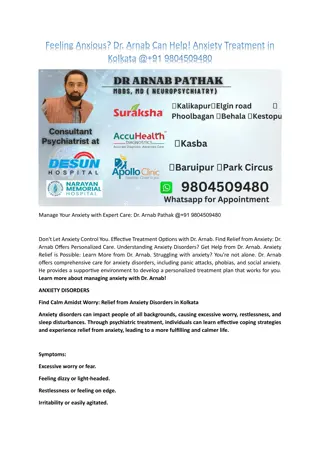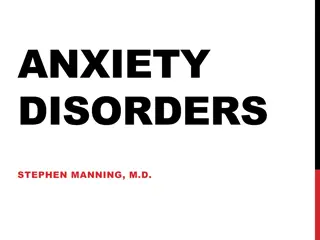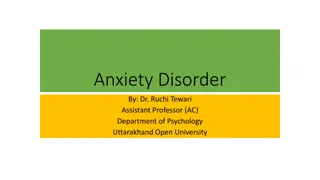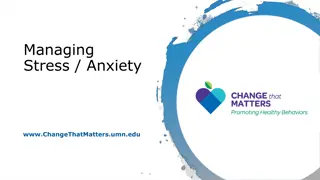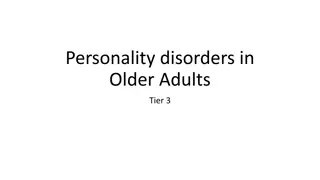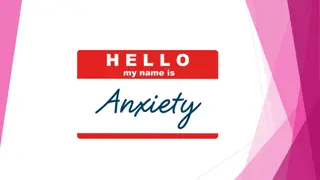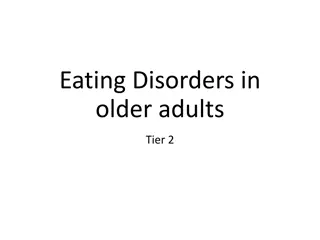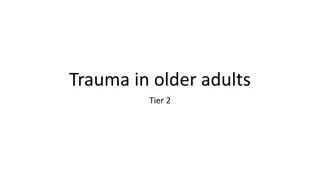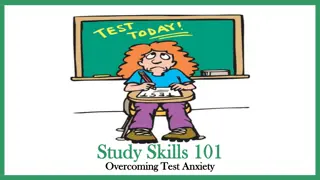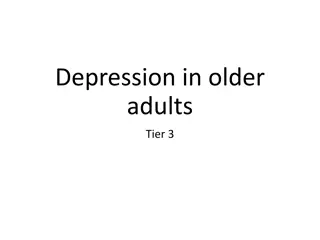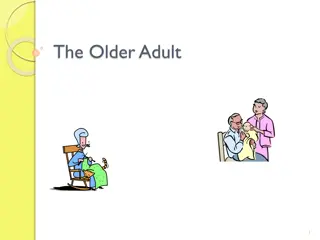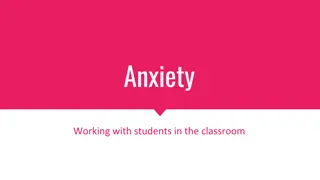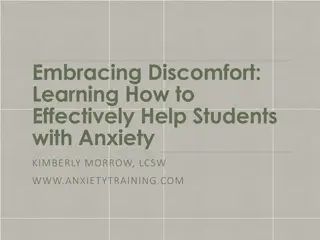Understanding Anxiety Disorders in Older Adults
Anxiety disorders in older adults are prevalent but often unrecognized. These disorders can manifest alongside depression, impacting daily life. Risk factors include gender, education, health status, traumatic events, and more. Types of anxiety disorders include generalized anxiety, phobias, panic disorder, and OCD. Recognizing symptoms and providing appropriate support are crucial for managing anxiety in older adults.
Download Presentation

Please find below an Image/Link to download the presentation.
The content on the website is provided AS IS for your information and personal use only. It may not be sold, licensed, or shared on other websites without obtaining consent from the author. Download presentation by click this link. If you encounter any issues during the download, it is possible that the publisher has removed the file from their server.
E N D
Presentation Transcript
Anxiety disorder in older adults Tier 3
Anxiety disorder Anxiety, although experienced by most people, does not usually develop into an anxiety disorder. Transient anxiety is normal, however when anxiety starts to affect daily life this indicates a problem. Anxiety disorders are commonly unrecognised or undiagnosed and when anxiety disorders coexist with depression, the depressive episode may be recognised but the underlying anxiety disorder may be overlooked. Depression and anxiety or anxiety disorders are commonly experienced together in some form, but can also be experienced alone. There are several terms used to describe the combination of depression and anxiety, including mixed anxiety and depressive disorder and depressive anxiety.
Anxiety disorder in older adults Anxiety is one of the most common psychiatric disorders in the older population About 1 in 5 older adults have anxiety disorder Older adults in comparison to younger adults often report physical health symptoms Most older adults with anxiety would have had anxiety symptoms when they were younger There could be trigger events for anxiety presentations falls, admission to hospital, recent bereavements and sudden loss
Risk factors for Anxiety disorder in older adults Female Low education attainment Lower socio-economic status Single or widowed Poor physical health - self rated poor health included Traumatic event (especially in childhood) Neuroticism Cognitive disorder Presence of major illness in partner
Types of anxiety disorder Generalised anxiety disorder Phobias Panic disorder Obsessive compulsive disorder Post traumatic stress disorder (see details in trauma slides)
Description of types part 1 Generalised anxiety disorder generalised and persistent anxiety not restricted to any specific event Phobias - anxiety evoked in certain well defined situations that are not currently dangerous. Examples include agoraphobia (fear of going out), social phobia, fear of falling Panic disorder - recurrent attacks of severe anxiety not restricted to any particular situation or circumstances
Description of types part 2 Obsessive compulsive disorder - recurrent obsessional thoughts or compulsive acts Post traumatic stress disorder - delayed or protracted response to a stressful situation of an exceptionally threatening nature
Causes of anxiety There can be a number of causes for anxiety symptoms. Some of them are: Depression Anxiety can be a symptom of dementia Medical illness Medications Alcohol and drug misuse
Symptoms Restlessness and or agitation Poor sleep Poor appetite Nervousness Irritability Tachycardia Dry mouth Nausea Sweating Muscle pains Fatigue Difficulty in sustaining attention and poor concentration Inability to retain information
Differences in symptoms in working age and older adults Working age adults Older adults Anxiety symptoms muscle tension, worry, fatigue, sleep disturbances Anxiety symptoms - muscle tension, worry, fatigue, sleep disturbances Severe panic symptoms Lower level of cognitive and somatic distress For working age adults with obsessive compulsive disorder - more obsessional symptoms More rituals - contamination and religious obsessions PTSD - more severe psychological symptoms More severe physical symptoms and functional impairment GAD worries related more to work, financial, future, social GAD more health related worries Panic disorder severe panic attacks Panic disorder more dizziness and faintness
Assessment of anxiety Interview the person and the care giver Older adults may underplay the symptoms such as avoiding going out due to fear of falls Important to look for impact on functioning Anxiety associated with dementia - assess cognition Medical illness can present with anxiety symptoms Physical health medications can make people anxious Alcohol and drug use should always be asked about. People use it to manage anxiety but alcohol can worsen the anxiety symptoms
Investigations Investigations including considering blood tests, thyroid function tests, blood sugar, ECG, blood calcium and potassium levels and sodium, kidney function tests, urine analysis and drug screening Review medications some medications such as Parkinson s disease treatment can cause anxiety Drug and alcohol use Cognition
Treatment Having a supportive caregiver can help Do: Talk in a neutral tone Use very simple words and sentences. And speak slowly. Give one instruction at a time If asking for something, please give maximally two choices at a time Sleep regularity can help with anxiety
Treatment Consider interventions which include consideration of sleep, diet and exercise Psychological therapy - relaxation therapy for GAD, systemic desensitisation for phobias, exposure and response prevention for OCD, EMDR ( Eye Movement Desensitisation Reprogramming) for PTSD Cognitive therapy - CBT Mindfulness
Treatment Treatment of anxiety can include medications such as anti- depressant or antiepileptic medications SSRI ( antidepressants) are the first line of treatment. When started on SSRI, monitor the patient for hyponatremia Avoid using benzodiazepines if at all possible (increased risk of falls and cognitive decline) Refer to the old age psychiatry team for assessment if you need to clarify diagnosis Refer to the old age psychiatry team if the older adult is experiencing severe anxiety symptoms which do not settle
Complications of GAD Complications of generalized anxiety disorder includes serious disability and impaired quality of life, impaired social and occupational functioning, increased risk of major depression, social anxiety disorder, and alcohol and drug misuse. Physical health problems are more common in people with GAD. These include chronic pain syndromes, asthma or chronic obstructive pulmonary disease, and inflammatory bowel disease. Suicidal ideation and attempts are also more prevalent in people with GAD compared to the general population and this risk increases further in those who also suffer from major depression
Resources MPC_07_01 Anxiety | MPC_07_01 Anxiety (mindedforfamilies.org.uk) This is an easy to access website for older adults and their families which has good information on symptoms ,reasons and treatments for anxiety



